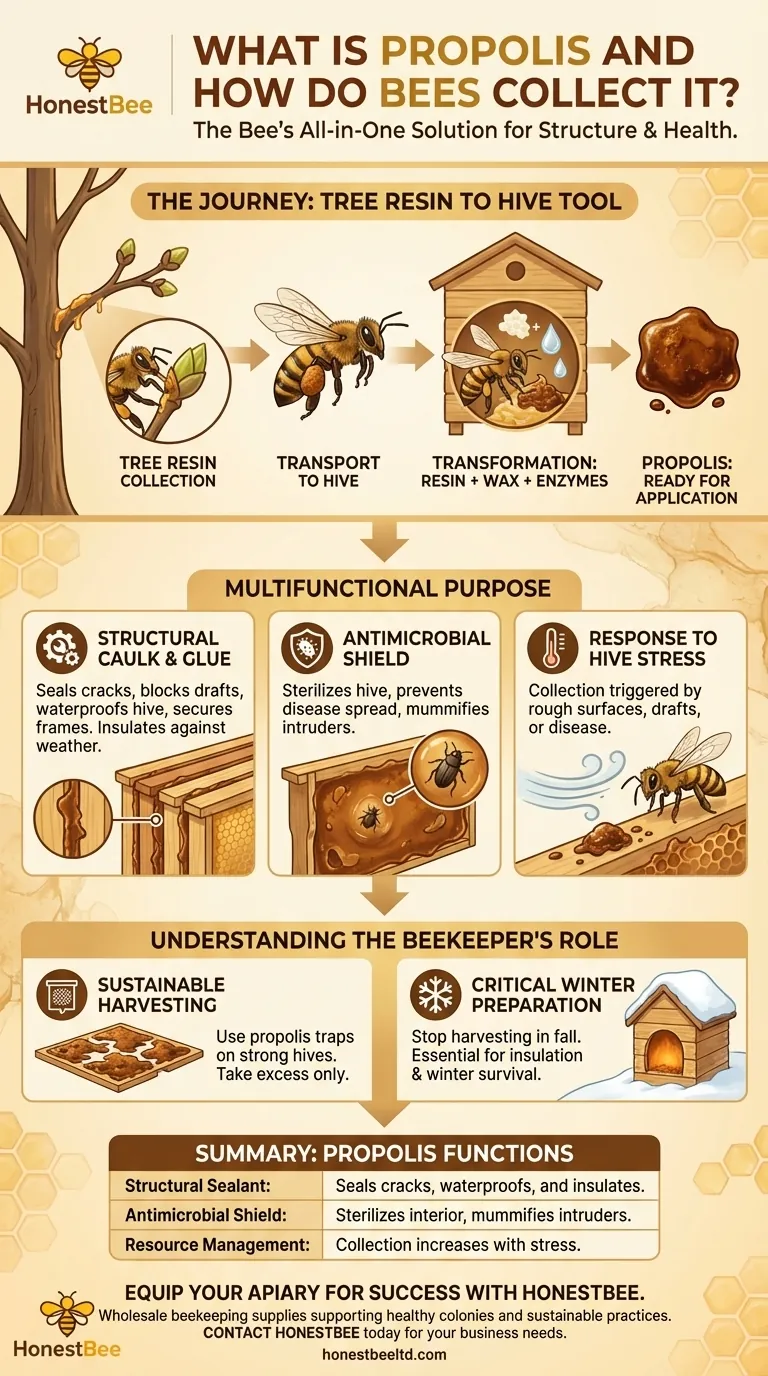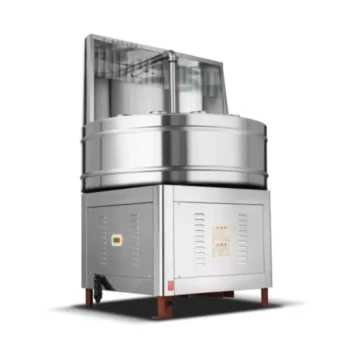In essence, propolis is a resinous compound that honey bees create to seal, disinfect, and reinforce their hive. Forager bees collect sticky resins from various plants and trees, carry them back to the colony on their legs, and mix them with beeswax and their own enzymes to produce the final substance, often called "bee glue."
More than just a simple glue, propolis is the bee's all-in-one solution for structural engineering and public health. It functions as a combination of caulk, disinfectant, and insulation, safeguarding the colony against weather, disease, and intruders.
The Journey: From Tree Resin to Hive Tool
The creation of propolis is a deliberate and vital process for the honey bee colony, turning a raw plant material into a sophisticated tool.
The Collection Process
Forager bees seek out plants and trees—such as poplars, birches, and conifers—that produce a sticky resin. These trees use resin as a defense mechanism to seal wounds and protect against fungal or insect attacks. Bees scrape this resin from leaf buds, twigs, and bark.
They then pack the sticky substance into the pollen baskets on their hind legs, just as they do with pollen, and transport it back to the hive.
Transformation Inside the Hive
Once the raw resin is inside, worker bees take over. They chew the resin, mixing it with their own saliva (which contains enzymes) and beeswax.
This transformation results in propolis, a potent and versatile compound that is ready to be applied throughout the hive.
The Multifunctional Purpose of Propolis
Bees don't just create propolis; they use it with remarkable precision to solve several critical challenges to their survival.
A Structural Caulk and Glue
The most visible use of propolis is as a structural sealant. Bees use it to seal any small cracks or unwanted gaps in the hive, typically those smaller than the proper "bee space" of 5/16th of an inch.
This caulking action blocks drafts, prevents unwanted light from entering, and waterproofs the hive, providing crucial insulation against the elements. They also use it to secure frames and hive boxes, living up to its "bee glue" name.
An Antimicrobial Shield
Propolis possesses powerful antimicrobial, antibacterial, and antifungal properties. Bees coat the interior of the hive with a thin layer of it, effectively sterilizing their living space.
This creates a clean environment that helps prevent the spread of disease within the densely populated colony. Bees even use propolis to embalm and mummify intruders like mice or large beetles that are too big to remove, neutralizing them as a source of infection.
A Response to Hive Stress
Propolis collection is not constant; it is a behavior triggered by specific needs. The presence of rough surfaces, drafts, or disease within the hive will stimulate the bees to forage for more resin and produce more propolis.
Understanding the Beekeeper's Role
While propolis can be seen as a sticky nuisance that glues hive components together, it is also a sign of a healthy colony and a valuable resource. Managing it requires a sense of responsibility.
The Principle of Sustainable Harvesting
Beekeepers can harvest excess propolis using a special tool called a propolis trap, which is a plastic mat with small gaps that bees are compelled to fill.
However, harvesting should only be done from strong, thriving hives that are producing an excess of propolis. Weakening a colony by taking too much can compromise its health.
The Critical Winter Preparation
It is crucial for beekeepers to stop harvesting in the fall. The insulating and waterproofing properties of propolis are essential for the colony's ability to survive the cold, damp conditions of winter.
Removing their "winter-proofing" material late in the season can leave the hive vulnerable and significantly reduce its chances of survival.
Making the Right Choice for Your Goal
- If your primary focus is bee biology: Understand that propolis is a key evolutionary advantage, serving as the colony's external immune system and its primary construction material for environmental control.
- If your primary focus is beekeeping: View propolis not as a sticky problem but as an indicator of hive health and a vital resource for the bees' survival, especially through winter.
- If your primary focus is natural compounds: Recognize propolis as a sophisticated substance derived from defensive plant resins, which bees then enhance to protect their entire society.
Ultimately, propolis is a testament to the honey bee's ingenuity, demonstrating its ability to harness nature to create a perfectly engineered and sterile home.
Summary Table:
| Propolis Function | How Bees Use It |
|---|---|
| Structural Sealant | Seals cracks, waterproofs, and insulates the hive. |
| Antimicrobial Shield | Sterilizes the hive interior and mummifies intruders. |
| Resource Management | Collection increases in response to drafts or disease. |
Equip your apiary for success with HONESTBEE.
Understanding the vital role of propolis is key to maintaining a healthy, productive colony. At HONESTBEE, we supply commercial apiaries and beekeeping equipment distributors with the high-quality, durable supplies needed to support these incredible natural processes.
From hive components that work with bee behavior to harvesting tools for sustainable propolis collection, our wholesale-focused operations ensure you get the reliable equipment your business depends on.
Contact HONESTBEE today to discuss your wholesale needs and discover how our products can help your colonies thrive.
Visual Guide

Related Products
- Professional Wide Blade Honey Scraper for Beekeeping and Honey Processing
- Professional Long-Handled Silicone Honey Scraper for Beekeeping
- Honey Wax Separating Wax Press with Metal Screw Wax Separator Machine
- Stainless Steel Honey Press Wax Press with Tank
- Stainless Steel Pail Perch Bucket Bench
People Also Ask
- Why are my bees not capping honey? Understand the Key to Perfect Honey Ripening
- What are wax cappings in the context of honey extraction? The Beekeeper's Guide to a Second Harvest
- What other tools are available for honey uncapping besides knives? Find the Right Tool for Your Apiary's Scale
- Why is my honey frame not capped? Your Guide to Perfectly Ripe Honey
- Why is uncapping necessary in honey harvesting? Unlock Your Honey Yield & Preserve Comb



















